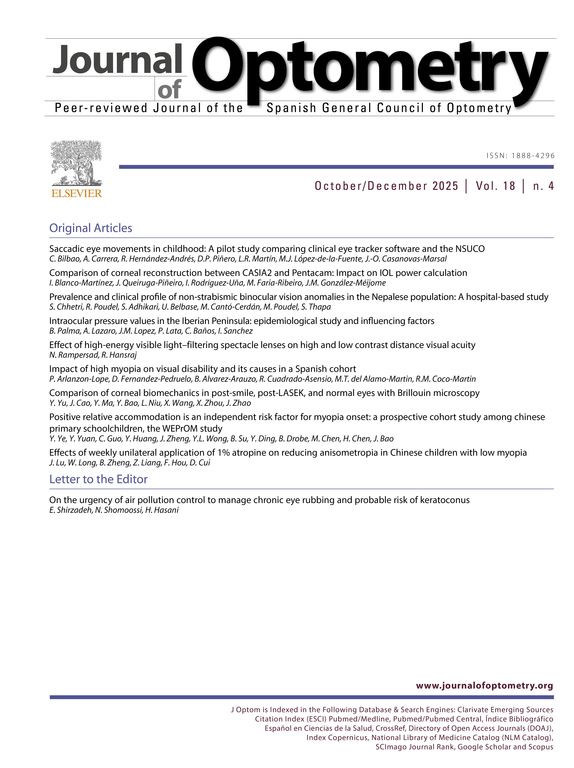This is in reference to the article titled: "Assessment of binocular vision and accommodation in myopic children wearing defocus incorporated multiple segments (DIMS) spectacle lenses for 24 months" published in the current issue of the Journal of Optometry.1 We read this article with great interest and thank the authors for providing an excellent study examining the effects of DIMS lenses on binocular vision and accommodation in children with myopia.
The study investigated binocular vision and accommodation changes in Malay myopic children following long-term DIMS spectacle lens wear. The researchers found significant changes including near point of convergence recession, reduced amplitude of accommodation, increased distance positive fusional vergence, improved stereopsis, reduced accommodative lag, and increased accommodative convergence to accommodation ratio. While DIMS lenses effectively controlled myopia progression, clinically significant binocular vision adaptations occurred. The authors concluded that regular near point of convergence monitoring is recommended to maintain optimal binocular vision function in children wearing DIMS lenses for myopia control.
In the interest of thoroughness, we would like to add a few insights into the role of visual perceptual learning (VPL) and cortical plasticity in research that were not mentioned. These mechanisms may help explain the binocular enhancements observed with DIMS lenses, beyond motor adaptation alone.
While the authors highlighted motor adaptation as a key factor in these outcomes, we propose that DIMS lenses may additionally engage VPL mechanisms and cortical plasticity, which could contribute to the binocular improvements observed. DIMS lenses provide identical optical input to both eyes through a central clear zone surrounded by repeating peripheral patterns of relative plus defocus.2,3 Although this design does not create interocular disparity, it establishes a consistent intraocular stimulus requiring continuous integration of sharp and blurred regions. Prolonged exposure to this structured spatial input may facilitate adaptive changes in visual system processing.2,3
The foundation for this visual plasticity hypothesis can be found in established perceptual learning research. A study examined evidence demonstrating that perceptual learning can develop without interocular differences or structured training protocols.3 Evidence from the studies demonstrated that patients with amblyopia who practiced identifying simple visual patterns known as Gabor patches, presented binocularly, showed enhanced visual acuity and contrast sensitivity in both eyes, including the untrained eye, indicating widespread cortical adaptation.3-7 Recent evidence form several studies shows that such training can induce broad functional gains in binocular vision, beyond improvements in acuity and contrast sensitivity.3,8,9 For instance, binocular perceptual learning protocols have been shown to improve positive fusional vergence at distance as well as near point of convergence (NPC), with reductions in NPC recession following targeted visual tasks.4-7 Virtual reality based perceptual learning has been demonstrated to enhance stereopsis, reduce accommodative lag, and increase the accommodative convergence to accommodation (AC/A) ratio.3,8 Other studies reported increased amplitude of accommodation and concurrent reduction in accommodative lag after binocular training, while additional work confirmed significant AC/A ratio gains together with improved distance fusional convergence.3,5,7,8 Emerging amblyopia therapies highlights that these improvements are consistent with widespread cortical and oculomotor adaptation driven by binocular perceptual learning, influencing vergence, accommodation, and stereopsis control pathways.3-8
Findings indicate that repetitive training on contrast-detection tasks can lead to significant improvements in visual acuity among adults with amblyopia, even in the absence of monocular stimuli or motor interventions.8 The findings revealed that structured visual exposure alone achieved through repeated practice sessions-was sufficient to induce lasting visual improvements.4-8 This parallels the continuous visual stimulation provided by DIMS lenses during daily wear, suggesting that consistent exposure to specific optical conditions may promote beneficial neural adaptations in the visual system.5-8
Contemporary research continues to validate these mechanisms in binocular vision contexts. Recent research examined the effects of identical binocular visual input with controlled variations in contrast and stimulus size among adults with anisometropic amblyopia.9 The study demonstrated reduced interocular suppression, enhanced binocular cooperation, and improved balance between the eyes without using dichoptic stimuli. These findings support the concept that symmetric, structured visual input such as that provided by DIMS lenses can promote functional binocular plasticity.9
Recent neuroimaging evidence further supports the role of neuroplasticity in binocular vision adaptation. A recently published study reported that office-based vergence and accommodative therapy significantly increased resting-state functional connectivity within the oculomotor vergence network, with changes correlating to clinical improvements in near point of convergence and positive fusional vergence.10 These findings indicate that targeted visual interventions can reorganize brain networks responsible for binocular control.10 By analogy, prolonged DIMS lens wear providing structured, symmetric binocular stimulation may induce similar connectivity changes, enhancing sensory-motor integration and potentially attention-related brain functions.10 Incorporating neuroimaging into future DIMS studies could help confirm this dual mechanism and refine intervention strategies.
To conclude, we propose that the binocular vision improvements observed with DIMS lenses stem from a dual mechanism involving both motor adaptation and visual perceptual learning. The lenses' structured optical design, featuring a central clear zone surrounded by peripheral defocus patterns, provides consistent binocular input that may drive cortical plasticity, thereby enhancing near point of convergence, stereopsis, and accommodation. This perspective broadens our understanding of DIMS lens efficacy beyond motor adaptation alone. Future studies incorporating neuroimaging techniques, such as fMRI, could help clarify these neuroplasticity mechanisms by examining changes in oculomotor and attention-related neural networks. Additionally, integrating DIMS lens wear with targeted binocular training protocols may further optimize visual outcomes. These insights could inform the development of more advanced myopia control strategies and improve clinical monitoring protocols for binocular vision function in myopic children.
Financial supportThe authors of this letter did not receive any specific grant from funding agencies in the public, commercial, or not-for-profit.
The authors have no conflicts of interest to declare.







